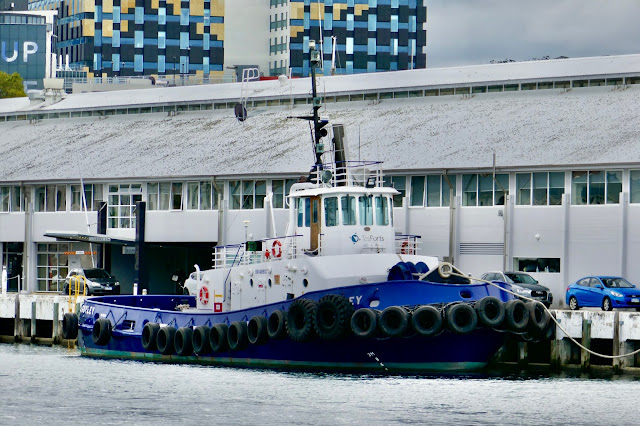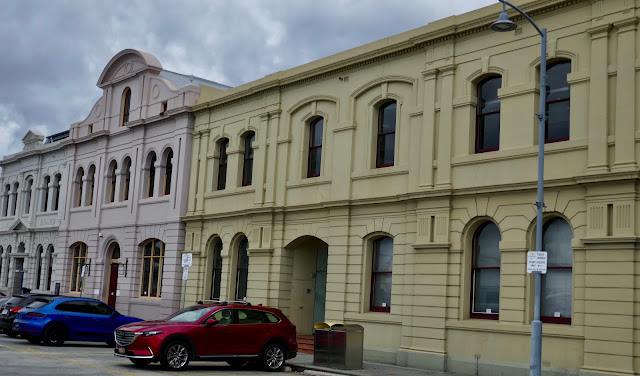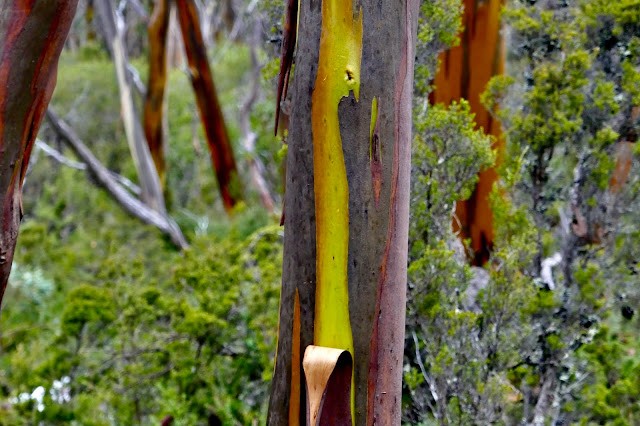On April 10, a little band of 11 intrepid souls together with 2 guides - a fellowship of the ring - set out to walk the Overland Track from Cradle Mountain to Lake St Clair in Tasmania. On April 15, a littler band of 7 intrepid souls together with 2 guides boarded the bus at Derwent River to return us home. Along the way, we did encounter storms and perils, blizzards and deep snow, torrential rain and slippery roots, rocks, mud and duck boards.
Herein lies the tale of our Overland Odyssey.
On the first morning, we met at 'base camp' at 6.30am to collect and organise gear, and then make the 2 hour bus trip to Cradle Mountain National Park. We started walking at around 11am. It was cold, wet and windy with the first hints of sleet falling ... Almost immediately we began climbing. After an hour or so, we broke through to this first glacial lake - Cradle Lake - bordered by glowing Myrtle Beech trees, Australia's only native deciduous trees.
As we climbed higher, the wind grew stronger, the sleet more insistent - becoming snow. It was strange to see native Pandani (looking like out of place cacti) in these high, cold parts.
(Not that Sarah could see very much at all!!)
It was a long cold slog, with a late arrival to our first hut. It snowed all night, and the next morning we woke to a transformed landscape - wonderfully picturesque from the safety of the warm hut, but a somewhat daunting prospect to walk through all day.
Much of the track this day was covered by a narrow raised platform (duck boards) designed to protect the fragile ecology of the area. Under normal circumstances, this allows for fast, smooth walking as well. However. once covered with snow and ice, their edges invisible, they make for treacherous treads - again and again we slipped off the edges into deep snow and icy water, with many falls ensuing. It took us 6 exhausting hours to travel the 6km to the lunch hut - only half the day's distance.
People's spirits kept remarkably high, but some members were struggling physically and the guides took the decision to split our group in two. Faster walkers went ahead with one guide; those needing more time followed behind with support from the other guide and Neil. It was a tough afternoon and evening for both parties, with ferocious cold winds and perilous paths. Night fell before we got in - the first party at about 7pm and the second at 9.30pm - to general relief and rejoicing.
By this time, the camera was somewhat waterlogged and took a couple of days to recover. When it did, conditions had eased a bit and we had two days of relatively mild and stable weather - though our mountain views were persistently obscured by mist and cloud, and thawing snow meant water everywhere on the ground!
The vegetation varied greatly along the way, with button grass plains and wondrous, old-growth rainforests. Mid-way along the track presents the only opportunity to 'walk out' via a side-route called the Arm River Track. Given the rigours of the journey so far, three of our number decided it would be best for them to take this option. One of our guides walked them half-way out, and they were met by another guide from the Tasmanian Walking Company to escort them back to base. The previous evening, Sarah facilitated a session reflecting on the dynamics of pilgrimage and enabling each of us to begin to articulate the meaning of the journey we were making.
The rain brought out many startling patches of fungi - as well as these orange flames, there were blue pixie parasols, dark purple and plum toadstools, tiny yellow outcrops and white mushrooms... some of which the ailing camera couldn't quite manage.
The quantity of water on the track was by now extraordinary.
This little island in the middle of two falls contains four species unique to Tasmania - a King Billy Pine, a pandani, and others we can't remember (a banksia and myrtle?).
Along the way, we encouraged people to distil their experience by means of haiku. The roots across the track were incredibly striking and led to Sarah offering the following:
Patient, pain-bearing,
roots, grip the earth with fierce love,
never letting go.
King Billy pines.
The beginning of the 'stairway to heaven', leading to Pelion Gap, where we hoped to do a side trip to Mount Ossa (Tasmania's highest mountain).
Alas, the weather was closing in again, leaving shy Ossa hidden in seclusion. So we had a quick stop for lunch at the gap before pressing on for our evening destination - Kia Ora hut.
This was a joyous day - the wind and the snow had eased and we revelled in the beauty of it all.
These Tasmanian yellow gums have the most striking trunks.
Cathedral Mountain from the window of Kia Ora hut - what a view!!
Next day we plunged again into old growth forest - and watery paths!!
Water, water everywhere, and rain, rain and more rain.
A reduced fellowship of the ring.
Normally, sedate creeks were flowing with gusto.
And then this, Fergusson Falls in full flow - an awesome sight and sound.
After a few hours in this forest with the rain falling and the water flowing, despite my best efforts to keep it dry the camera failed again.
On our final day the rain continued falling steadily until the last kilometre when we crossed this wonderful suspension bridge. Alas, just moments before this another of our number fell and broke her arm. She managed to walk to Lake St Clair and take the ferry to Derwent Bridge where an ambulance was waiting to transport her to Launceston. At this point we heard that three others had been evacuated from the area in the past days and that a number of other groups had had to turn back or be cancelled.
And so our journey came to an end with spirits a little dampened by the attrition of our party, but still deeply grateful for the experience. Everyone - wherever and however they finished the walk - has said how significant it has been for them and what a privilege to touch into this wilderness country. We shared Michael Leunig's poem 'No Sooner' on the final morning - it ends with the lines:
'And then you will have passed through it,
and with mysterious consequence
it will have passed through you'.
And a beautiful summation by our friend Noela:
Sleet beaten, snow driven
Washed through by rain.
Elemental purification.
Worth all the pain.
































































